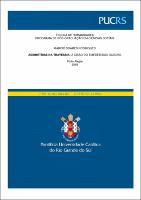| Share record |


|
Please use this identifier to cite or link to this item:
https://tede2.pucrs.br/tede2/handle/tede/8335Full metadata record
| DC Field | Value | Language |
|---|---|---|
| dc.creator | Rodrigues, Márcio Soares | - |
| dc.creator.Lattes | http://lattes.cnpq.br/7561671747944350 | por |
| dc.contributor.advisor1 | Madeira, Rafael Machado | - |
| dc.contributor.advisor1Lattes | http://lattes.cnpq.br/8183364643409377 | por |
| dc.date.accessioned | 2018-10-26T13:52:24Z | - |
| dc.date.issued | 2018-02-28 | - |
| dc.identifier.uri | http://tede2.pucrs.br/tede2/handle/tede/8335 | - |
| dc.description.resumo | A presente dissertação tem como objetivo principal responder à seguinte questão: quais fatores colaboraram para a definição dos emedebistas gaúchos pelo PMDB ou PDT quando do retorno ao pluripartidarismo no final da década de 1970? Buscamos responder das seguintes formas. Primeiro, faremos uma análise histórica do período pluripartidário que se inicia após o Estado Novo até os momentos finais do bipartidarismo, visando assim, conforme proposto por Panebianco (2005), priorizar a análise do momento de nascimento das legendas, principalmente as seções gaúchas do PTB e do MDB, bem como seu desenvolvimento em um contexto tão atípico para uma legenda oposicionista, buscando conhecer a estrutura e forma como o poder era distribuído dentro de ambas às organizações, assim como a consequência desta interação no momento da extinção do MDB. Segundo, através da análise da trajetória política da elite emedebista do Rio Grande do Sul, buscaremos encontrar padrões de carreiras políticas que possam elucidar a escolha da agremiação a ser adotada com o retorno do pluripartidarismo, priorizando assim aqueles líderes emedebistas que caminham para o PMDB ou o PDT. Com base na cobertura jornalística dos jornais Zero Hora e Folha da Tarde do período, vamos analisar ainda como os líderes emedebistas justificaram publicamente suas decisões a respeito dos partidos adotados com a extinção do MDB, visando assim, com base nos incentivos coletivos e seletivos de Panebianco (2005), verificar se estes utilizam de argumentos ideológicos e/ou doutrinários para explicar suas decisões, conforme a narrativa construída pelos principais líderes das duas legendas no período, Leonel Brizola e Pedro Simon. | por |
| dc.description.abstract | The main purpose of this research is to answer the following question: what were the factors that influenced the members of the MDB party to choose between PMDB or PDT when the multiparty system was restored in the late 1970? We intended to answer that question in two parts. First, we will do a historical analysis that goes from the multiparty system period - that began after the “Estado Novo” regime - until the final moments of the bipartisanship system, in order to, as proposed by Panebianco (2005), prioritize the analysis of the foundation of the political parties, especially the sections of PTB and MDB from Rio Grande do Sul, as well as its development in such an unusual context as an opposing party, seeking to know how power were distributed in both organizations and the consequences of this interaction when the MDB party was extinguished. Then, we will analyze the political history of the MDB members from the elite of Rio Grande do Sul, searching for patterns in their political careers that may elucidate the choices between the two parties, highlighting the MDB leaders that have decided to join PMDB or PDT. Based on the journalistic coverage of the newspapers “Zero Hora” and “Folha da Tarde” from that period of time, we will also investigate how those leaders publicly justified their decision, in order to, considering the Panebianco (2005) study of the collective and selective incentives, verify if they use ideological and/or doctrinal arguments to explain their decisions, according to the narrative structured by the main leaders of those two political parties in that time: Leonel Brizola and Pedro Simon. | eng |
| dc.description.provenance | Submitted by PPG Ciências Sociais ([email protected]) on 2018-10-25T19:12:11Z No. of bitstreams: 1 Márcio_Soares_ Rodrigues_Dis.pdf: 1650077 bytes, checksum: f295f0bb4fc140f92ad684e3b5956a9d (MD5) | eng |
| dc.description.provenance | Approved for entry into archive by Sheila Dias ([email protected]) on 2018-10-26T13:46:49Z (GMT) No. of bitstreams: 1 Márcio_Soares_ Rodrigues_Dis.pdf: 1650077 bytes, checksum: f295f0bb4fc140f92ad684e3b5956a9d (MD5) | eng |
| dc.description.provenance | Made available in DSpace on 2018-10-26T13:52:24Z (GMT). No. of bitstreams: 1 Márcio_Soares_ Rodrigues_Dis.pdf: 1650077 bytes, checksum: f295f0bb4fc140f92ad684e3b5956a9d (MD5) Previous issue date: 2018-02-28 | eng |
| dc.description.sponsorship | Coordenação de Aperfeiçoamento de Pessoal de Nível Superior - CAPES | por |
| dc.format | application/pdf | * |
| dc.thumbnail.url | http://tede2.pucrs.br:80/tede2/retrieve/173466/M%c3%a1rcio_Soares_%20Rodrigues_Dis.pdf.jpg | * |
| dc.language | por | por |
| dc.publisher | Pontifícia Universidade Católica do Rio Grande do Sul | por |
| dc.publisher.department | Escola de Humanidades | por |
| dc.publisher.country | Brasil | por |
| dc.publisher.initials | PUCRS | por |
| dc.publisher.program | Programa de Pós-Graduação em Ciências Sociais | por |
| dc.rights | Acesso Aberto | por |
| dc.subject | PTB | por |
| dc.subject | MDB | por |
| dc.subject | Cisão | por |
| dc.subject | PMDB | por |
| dc.subject | PDT | por |
| dc.subject.cnpq | OUTROS::CIENCIAS SOCIAIS | por |
| dc.subject.cnpq | CIÊNCIA POLÍTICA | por |
| dc.title | Assimetrias na travessia : a cisão do emedebismo gaúcho | por |
| dc.type | Dissertação | por |
| dc.restricao.situacao | Trabalho não apresenta restrição para publicação | por |
| Appears in Collections: | Programa de Pós-Graduação em Ciências Sociais | |
Files in This Item:
| File | Description | Size | Format | |
|---|---|---|---|---|
| Márcio_Soares_ Rodrigues_Dis.pdf | MARCIO_SOARES_RODRIGUES_DIS | 1.61 MB | Adobe PDF |  Download/Open Preview |
Items in DSpace are protected by copyright, with all rights reserved, unless otherwise indicated.




